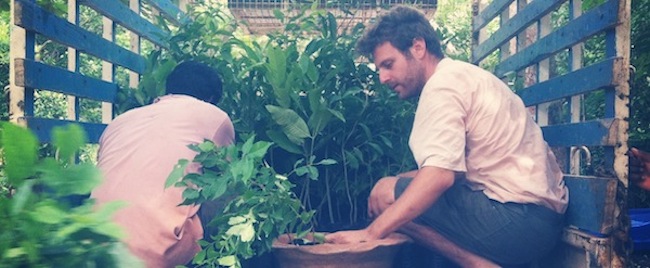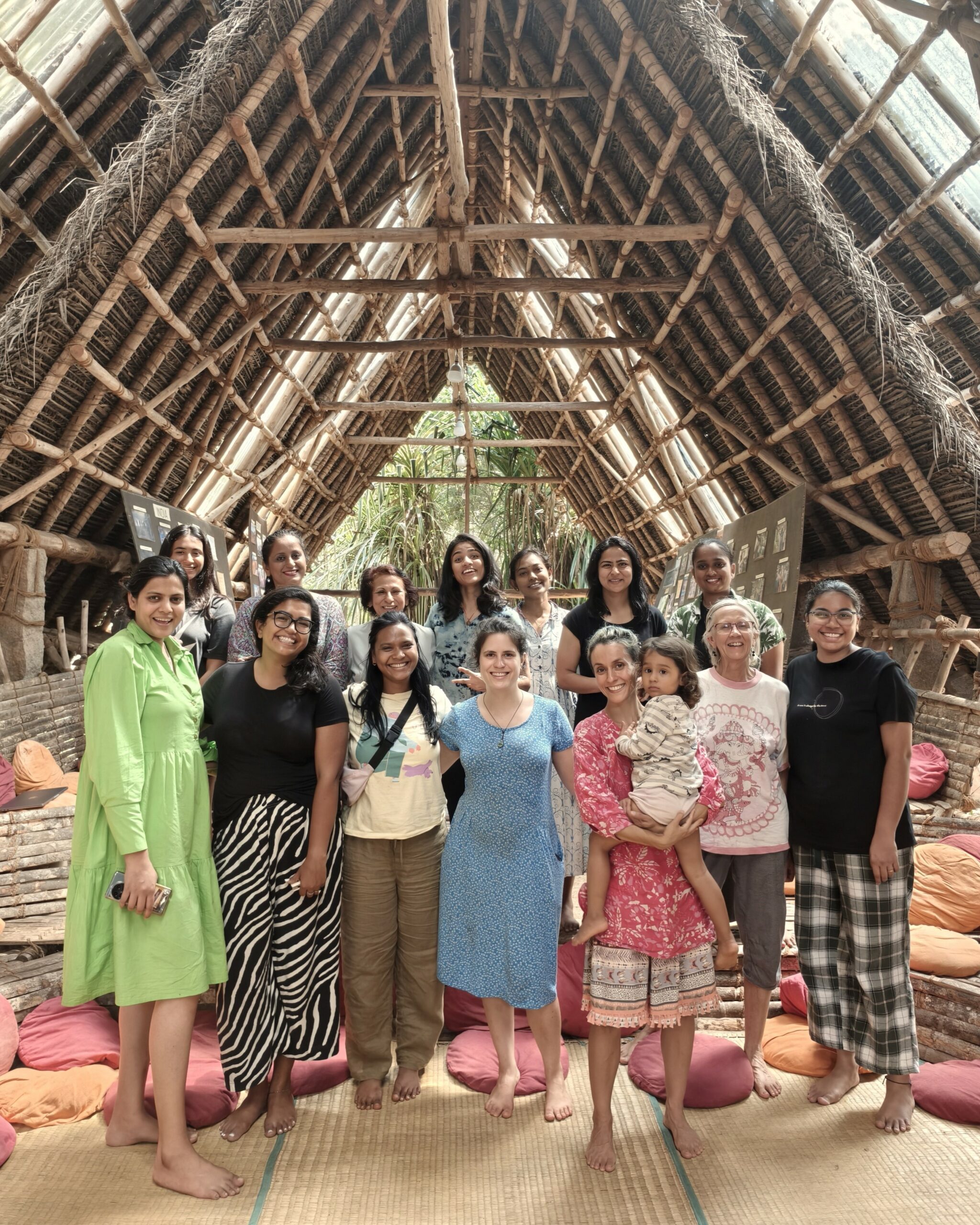Sadhana Forest India focuses on reforesting 70 acres of severely degraded land with the indigineous TDEF (Tropicla-Dry-Evergreen-Forest). The TDEF is on the verge of extinction as only 0.01% of what used to be a vast forest currently exists in small patches in South India.
The Tropical Dry Evergreen Forest (TDEF)
Each region of the world has a vegetation type that has, over countless eons, evolved as the plant community most suited to the environmental conditions of the area. The Tropical Dry Evergreen Forest (TDEF) is the indigenous forest of the coastal seaboard of Southeast India. Historically, the forest extended from Vishakapatanam to Ramanathapuram as a belt of vegetation between 30 and 50 km wide, bordered on one side by the sea and on the other side by a forest that becomes increasingly deciduous as one moves inland. It contains over 160 woody species of which around 70 are found within the pristine climax forest. This is predominantly composed of trees and shrubs that have thick dark green foliage throughout the year. There are six vegetative elements: trees, shrubs, lianas, epiphytes, herbs, and tuberous species. In the pristine state these components weave together to form a complex and diverse habitat that is home to a myriad of species, such as mammals, birds, reptiles, amphibians, insects, as well as a host of microbes.
When one includes all of the herbaceous species that grow in a variety of ecological niches within the range of the forest, the number of species approaches 1000, of which over 600 have a recorded use for humankind either medicinally, culturally, or in religious rituals.
The relevance of the forest today lies both within its vast botanical wealth and also its ability to mitigate the environmental conditions that are steadily deteriorating due to expanding population and to increasing consumer lifestyles. However, hardly any of this forest remains free from human interference; the vast majority of forests in the area are little more than degraded thorny thickets, lacking the inherent nobility of the climax vegetation. It is the intention of our project is to draw attention to the TDEF and put forward the case for its conservation.
Vegetation
The forest when in its pristine state is a tightly woven matrix of vegetation about 6 m (19.5 ft) high with the occasional emergent rising above the canopy to heights of 10 m. The trees and shrubs of the forest exhibit many characteristics that are similar, indicating a form of convergent evolution. They are typically evergreen, responding to the rains with a flush of new leaves. The leaves are mostly simple, thick and waxy, around 6 cm (2 3/8) in) by 3 cm (1 in) in size. The flowers are small- 1 cm (3/8 in) in diameter- often white with a perfume, and bloom generally between February and August. The fruits are small and fleshy, ripening mainly between April and September. Trees generally have around 2 m (6 1/2 ft) of clean trunk and then branch out. In some species buttressing is found. The overall height of the trees is between 4 m (13 ft) and 7 m (23 ft). The trees are slow growing, the wood is dense and hard, and thorns are absent although in this particular instance there are some notable exceptions.
Some of the common species exhibiting all or most of these characteristics are Atalantia monophylla, Diospyros ebenum, Drypetes sepiaria, Garcinia spicata, Glycosmis mauritiana, Ixora pavetta, Lepisanthes tetraphylla, Manilkara hexandra, Memecylon umbellatum, Syzygium cumini. Pterospermum suberifolium is also an integral part of the climax forest, but commonly part of the emergent layer, has many different physiological features which are probably due to the environmental conditions it experiences above the canopy. Its leaves are larger and thinner with white hairs beneath, its flowers are also larger, while the seeds are windblown.
Other important vegetative components of the forest are climbers/liana (eg. Combretum ovalifolium, Capparis zeylanica) and orchids, which are both epiphytic (eg. Vandia tesselata) and pseudobulbous (eg. Eulophia epidendraea).The lianas can be up to 30 cm (1 ft) in girth and can extend over 10 or more tree canopies. They do not follow the vegetative characteristics of the trees and shrubs, and this might indicate signs of disturbances. Orchids are rarely found in the forests today as these are the most vulnerable to disturbances.
Biodiversity
In present times, the highly degraded state of the forest and the high human population pressure means that the larger predatory mammals can no longer be found in the region. However, it is surprising that a number of small mammals do hang on, especially in the larger reserve forests of the area. It is thought that the pangolin- the honey badger- is still to be found, and in much larger numbers the porcupine, the hedgehog, the fox, and the mongoose reside in the forests. In specific areas (Point Calimere) the black buck (Antilope cervicapra) and the chital (Axis axis) are also found, while the bonnet macaque (Macaca radiata) is resident in most forests.
The reptiles of the forest include the monitor lizard, the chameleon, and other lizards, as well as 19 species of snake, including the “Big Four,” four venomous species of the plains, the cobra, the krait, and two vipers.
The bird population of the TDEF has been estimated to be around 80 species, and in certain areas the trees provide valuable roosting sites for water birds at night. The bird population is made up of both residents, who stay throughout the year, and migrants, who arrive with the rains and who often take advantage of the burgeoning insect population that is concurrent with the monsoon.
Less glamorous, but perhaps more important to the healthy functioning of an ecosystem is the insect population, and the other microfauna found within the leaf litter and humus layer. Little is known about these animals, but simple observations indicate a wealth that is yet to be studied. For example, in the leaf litter of an undisturbed forest in a sacred grove, from an area of one square meter, 5 species of spiders, 2 species of roaches, 2 species of ants, a bug, and a cricket were found, all accounting for 368 individual specimens!
The forests of the region have been intimately connected to humans for countless centuries. Prior to Roman times, when trade was exchanged with the coastal communities, civilization has been recorded in the area. And even before these times the coastal area would have attracted fishermen and the light sandy soils would have been accessible to primitive agricultural tools and crops.
During the last two hundred years these forests have been treated as a harvestable resource and this has lead to their degradation. However, even in today’s highly degraded state, there still remains a vast repository of natural resources. It has been recorded that almost all the local species have a use. Four hundred species of trees, shrubs and herbs are utilized in traditional medicine practiced by the villagers, from householders and midwives, to specialists treating bone fractures, poisonous bites, and eye ailments.
In India, modern medical health systems can only offer primary health care for up to 30% of the rural population. Plant based indigenous health systems can help with providing real health security as they are very much alive and are evolving and adapting to modern needs. This information on bioresource use represents a valuable record for posterity and also a phenomenal bank of information that can be drawn upon to resolve current predicaments.
As well as providing possibilities for the material and medical needs of the population, the forest also provides for the spiritual. In fact the only pristine areas of forest left are found around temples as sacred groves. The temples are often dedicated to the god Iyanar, and although all of these groves are suffering from disturbance within by pilgrims and at the edges from surrounding farmers, they still provide a setting for many stories that are told concerning the past.
Future of the Forest
The possibility to conserve, protect, and actually restore the Tropical Dry Evergreen Forest (TDEF) still exists today. Work has been carried out researching the forest, establishing which species exist to make up the matrix of the mature forest, collecting information as to when each species flowers and fruits, and developing techniques to germinate and raise the species in nurseries to plant out either as enrichment plantings in already existing forest, or to rehabilitate bare and barren land.
The next step needs to be taken, but still many questions need to be addressed. The future of this forest is dependent upon the local population rediscovering the respect that was once held for the forest and recognizing the role that it can play in the needs and necessities of today’s ever changing society. We need to work within these areas to ensure that the basic needs of the people are taken care for and to help to strengthen the community so that they can take care of the forest themselves.
In Sadhana Forest:
A unique characteristic of Sadhana Forest is that we are home to one of the few remaining sacred groves, containing original TDEF species. Through environmentally conscious and sustainable reforestation practices, work is being done to expand this area and restore the indigenous growth.
At the same time we are replacing the earlier-planted exotic species, such as acacias from Australia, with TDEF species. Since the beginning of the project, over 27,000 trees have been planted, the majority of which have survived and are showing slow but steady growth. Since its inception Sadhana Forest has replanted with TDEF species on over 70% of its land.
Meanwhile, we are running free educational workshops with the purpose of informing people about the history of the land, of its former devastation, and the ecological steps being taken to replant and restore it. The restoration process of creating a viable Sadhana Forest may take some 20-30 years.


